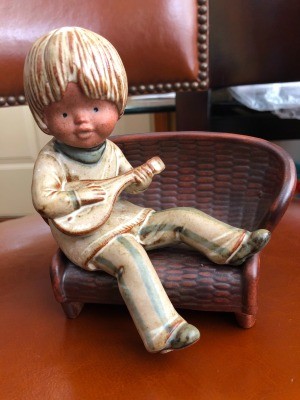 Hi, I am in need of help! I have been searching for any information about this cute item! I got it as a gift from a vintage fair stand about a year ago, but now due to the actual situation, I have to let it go. We're about to move and this new place doesn't have enough space to place a credenza to protect my items. Can anyone help me with material and the name?
Hi, I am in need of help! I have been searching for any information about this cute item! I got it as a gift from a vintage fair stand about a year ago, but now due to the actual situation, I have to let it go. We're about to move and this new place doesn't have enough space to place a credenza to protect my items. Can anyone help me with material and the name?
Any help will be appreciated! Thank you so much!
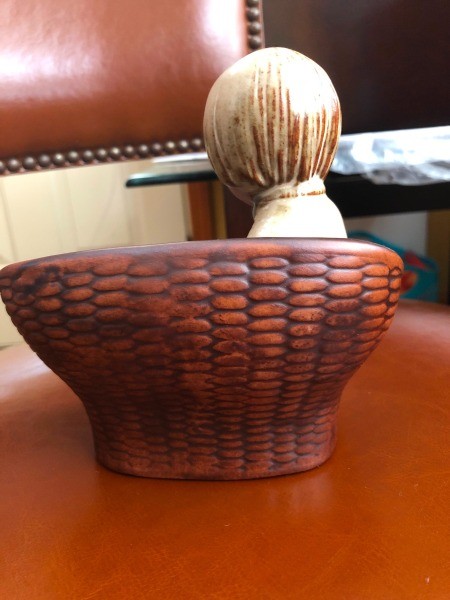
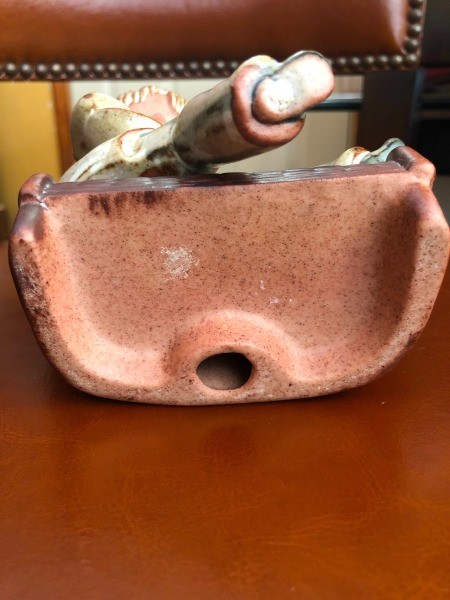
He is very cute. It is almost impossible to tell the material from a picture. The hole in the bottom leads me to think he is either ceramic or poured clay. He looks like a class project piece vs something store bought.
I say that because the paint job looks hand done.
I have been searching my greenware sources to see if I can find him. If I locate him, I will post back.
If you want to sell him, ask what you want to make for him and take best offer. Call him boy with ukulele sitting or lounging on woven chair. Be sure to include lots of photos. These are a great start.
Post back how your sale goes!
Ask a QuestionHere are the questions asked by community members. Read on to see the answers provided by the ThriftyFun community or ask a new question.
Just wondering if anyone knew what this was or had any information on it. Thanks.
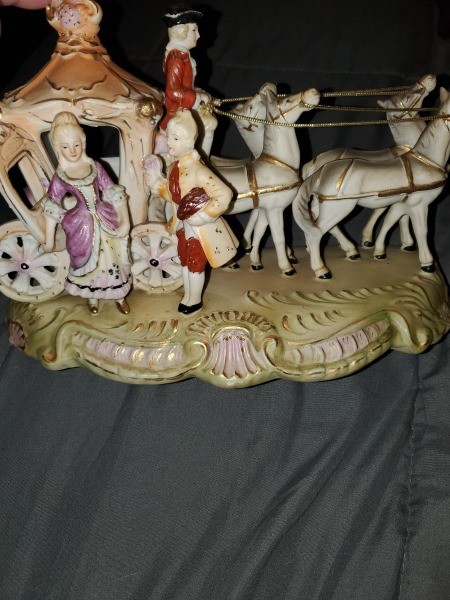
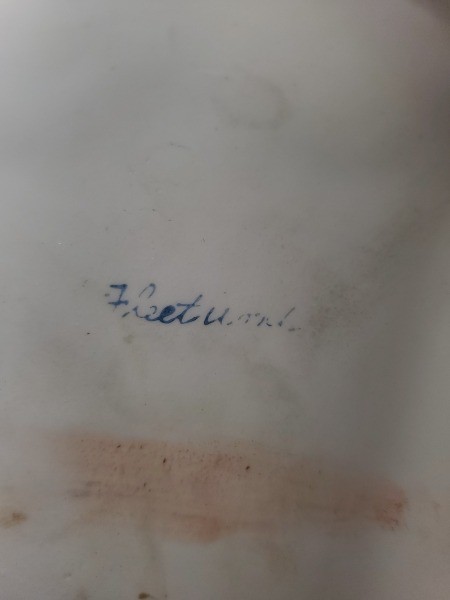
I believe this is an antique "Fleetwood" Dresden porcelain figurine.
I am not familiar with this brand and I cannot find any history of the company online which usually means it is not a prominent well known company.
I did see several pieces with statements like 'made in Japan' or 'Made in Germany' but no proof of that statement.
These inexpensive figurines have been in production since the 1930's and companies mass produced them and sent them to distributors in the US who sold to 5 & 10 cent stores so people could have low cost figurines that were similar to the high price figurines sold in the big department stores and jewelry stores.
Hopefully, another member will be able to supply better information so be sure to keep checking back.
I'd like to know what company made this and what is it worth? It was my mother's who is gone now, so I do not know the history.
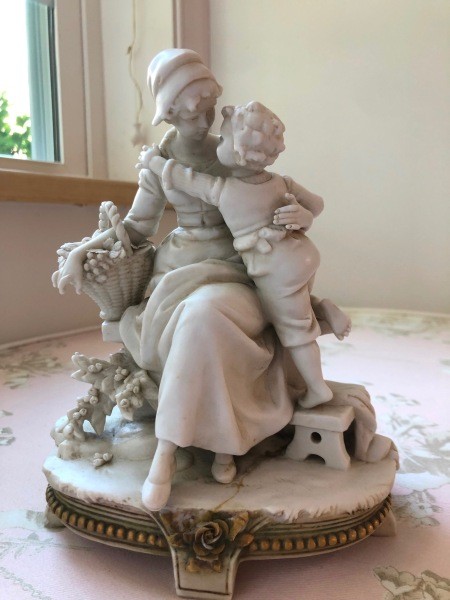
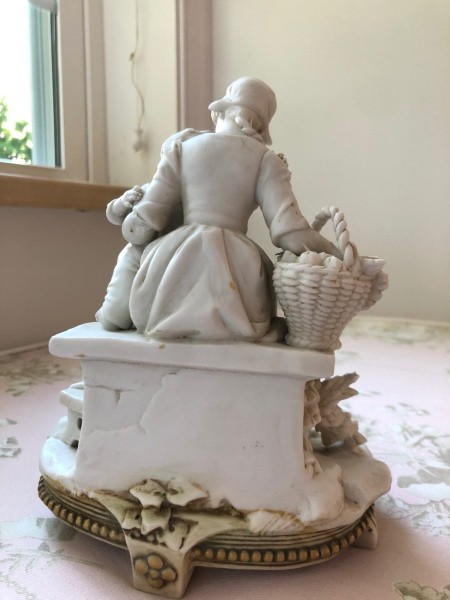
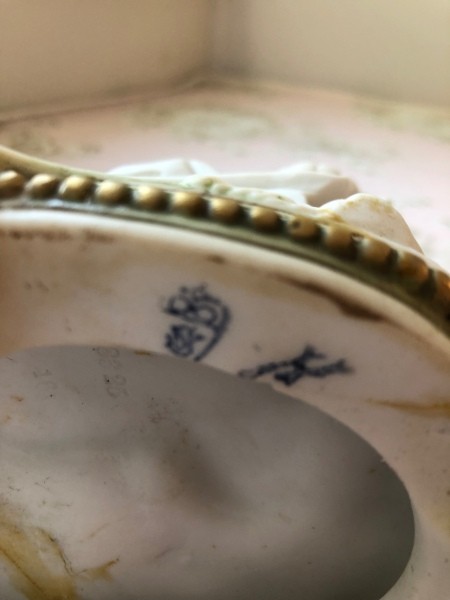
I think the mark is similar to mark of this plate Old Delft Sailor Boat River 9 1/2" made by Keller and Guerin in Saint Clement factory during the end of the 19th century:
www.french-treasures.net/
Price: $240
'Jacques Chambrette Senior initially started the first fine pottery works in Lorraine in 1711. His son began in 1722 by trading faience in Lunéville. He built his own factory there in 1730, just before he obtained the royal permission.'
www.wikiwand.com/
According to other sources the history of the Keller & Guerin factory dates to 1728 when Jacques Chambrette built his first factory in Luneville in the province of Lorraine.
flowblue.org/
France levied heavy taxes on goods imported from Lorraine, because Lorraine was an independent state at that time. To escape those duties, in 1758 Jacques Chambrette established a second factory - the faience factory of Saint-Clement, Meurthe-et-Moselle, only seven miles from Lunéville, but ln French territory . www.infofaience.com/
Richard Mique bought in 1763 the Saint-Clément factory.
In 1786 Sebastien Keller bought Luneville. About in 1832, Sébastien Keller's son aligned with his brother-in-law Guérin to give birth to the mark K&G (or KG) from the names Keller and Guérin. www.leblogantiquites.com/
I think your figurine was made by Keller and Guerin in the end of the 19th century.
I have been searching for any information on this highly detailed piece. I found her at a Thrift Store in California. She is 7X5 inches. I believe she is ceramic but possibly porcelain. It is Signed Lavado 1959 on the bottom along with a name, Mery Eliza Myrtle.
She is extremely detailed. It is possibly folk art. I would like to know any information on her.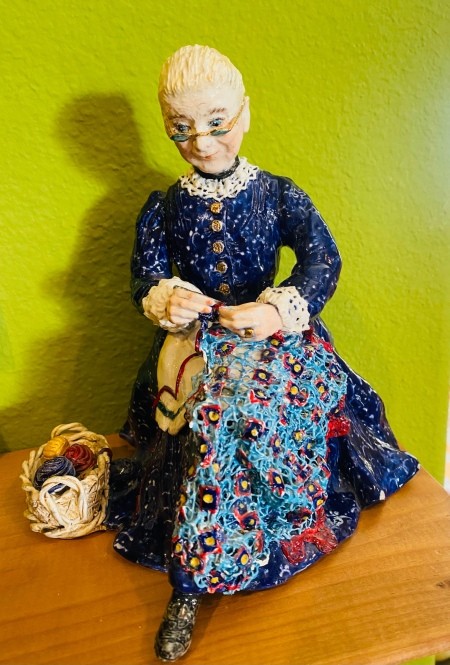


You have a very good example of how well a handmade/painted item can be made but it takes a good mold to start the process.
It appears Lavado was/is an artist who made/painted ceramic items for individuals. These were popular during the 60s-70s-early 80s - you could pick out a certain 'mold' at a ceramic shop and pay to have someone paint it for you.
The artist would paint it to your specifications (colors) and imprint your name (or any name/number/word you specified) along with their name and date on the bottom.
The item was 'fired' in a kiln to set/dry/harden it to the extent you see them today.
This is still a popular hobby today as you can see if you check how many types of 'molds' are listed for sale online.
There were several mold-making companies (some still in existence) but the most popular companies were the Atlantic Mold Company and the Holland Company. Molds made by larger companies were marked with their name/logo on the bottom of the mold.
Examples:
poshmark.com/
Your figurine is a 'one of a kind' and was probably well-loved/prized by Mery Eliza Myrtle, but maybe not her family, and was eventually donated to the thrift store.
Lucky you!
I found this figurine at a thrift store there are no markings on the bottom except 151. How do I find out more information on it and what the value of it might be?
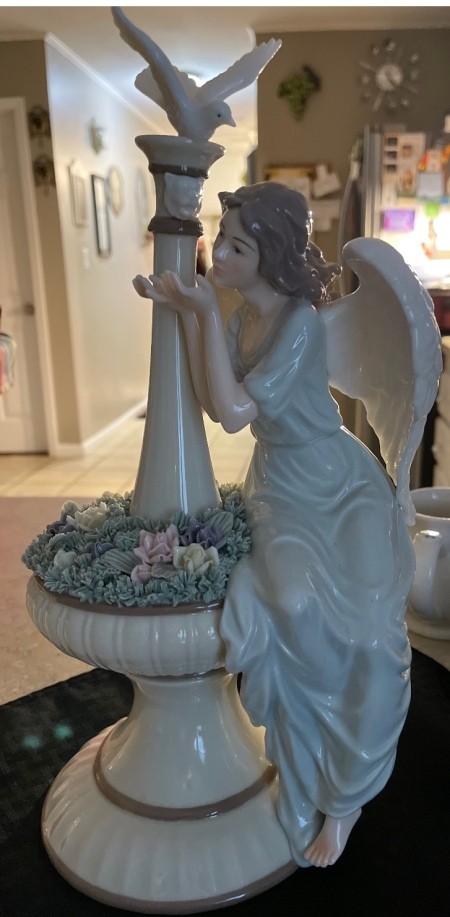
www.amazon.com/
She is the Grandeur Noel angel at fountain. If you can find one that has sold, that will be today's market value. She is very pretty.
Looking for information on this figurine with marking of 939 on bottom.
Not sure if this is part of the Piano Baby collection.
Piano Baby was a name used by several companies to describe the ornaments that were made to 'hold' silk shawls on top of the baby grand pianos that were so popular during the 20s to 40s.
They were manufactured by numerous companies well into the 20th century and ranged in size from 4 to 18+ inches.
Some of the more famous brands usually have their 'marks' on the items:
Manufacturers
A few producers of bisque piano babies were:
Heubach
Lefton
Andrea by Sadek
Conta & Boehme (Böhme)
History:
"Piano babies remained popular up until the First World War. Nevertheless, Japan started manufacturing reproductions in the 1950s, and they enjoyed a resurgence among collectors in the 1980/90s."
I believe your baby is probably from a later time but anyone can use the name 'piano baby' as there was never a patient place on this name. It probably is not one of the more valuable dolls.
This is a site that has some information about these dolls.
www.fabcollectibles.com/
www.unionleader.com/
All you have to do is go to Google to see how many variations are available and how difficult it would be to definitely identify an 'original' unless they had true markings.
www.google.com/
So I was wondering if anyone knew what this was and its value ? I'm pretty sure its ceramic. It's got a dull sound when you tap it and no shine to it like porcelain.
Any info would be greatly appreciated. Thanks in advance.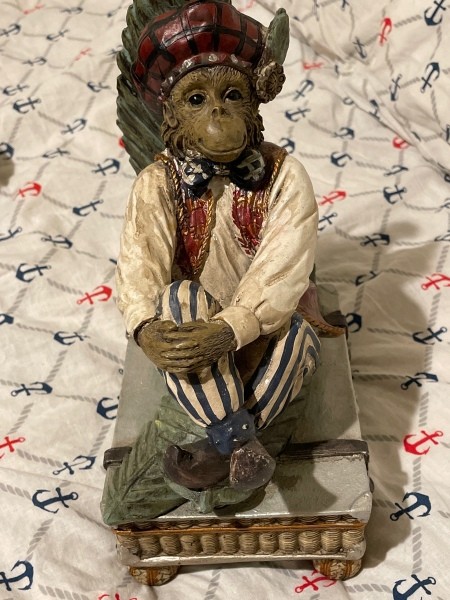
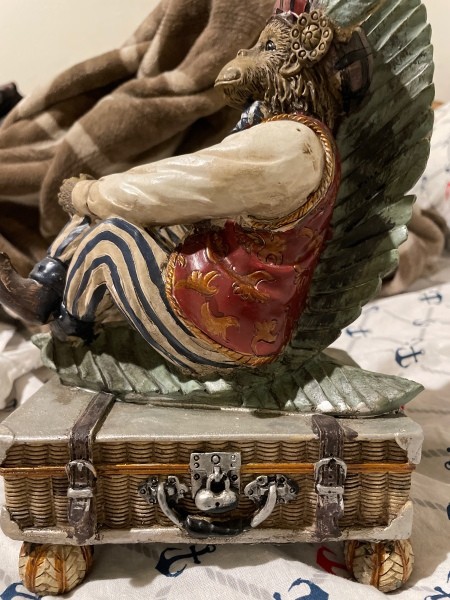
Your figurine has a "Made in China" sticker.
Mark "MADE IN CHINA" was required from 1919. In the 1950s, technology improved, paper labels were allowed and the paper label era began. So your figurine was made after the 1950s.
I could not find the exact same figurine. You have not written what size your figurine is.
Ceramic Pottery Chinese Monkey Holding Fruit Figurine Statue approximately 12" high is on sale for US $99.99
www.ebay.co.uk/
Came across this in my roof space. Just wondering if anyone knows who made this and what age? Checked for markings but can't seem to see any on it.
Curious to know, many thanks!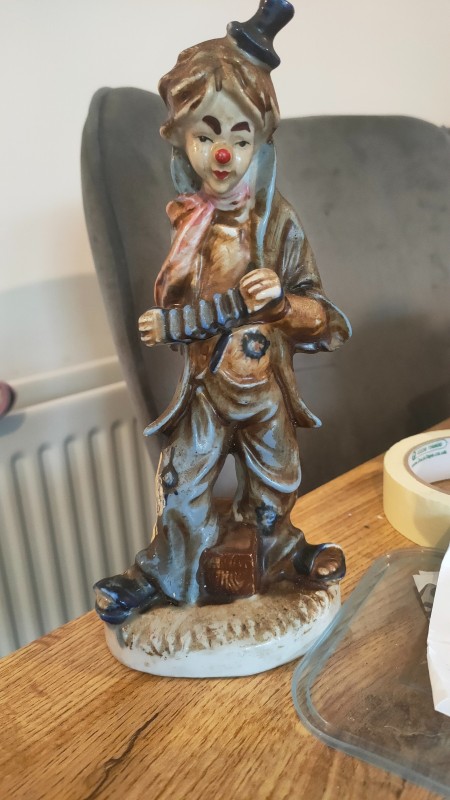
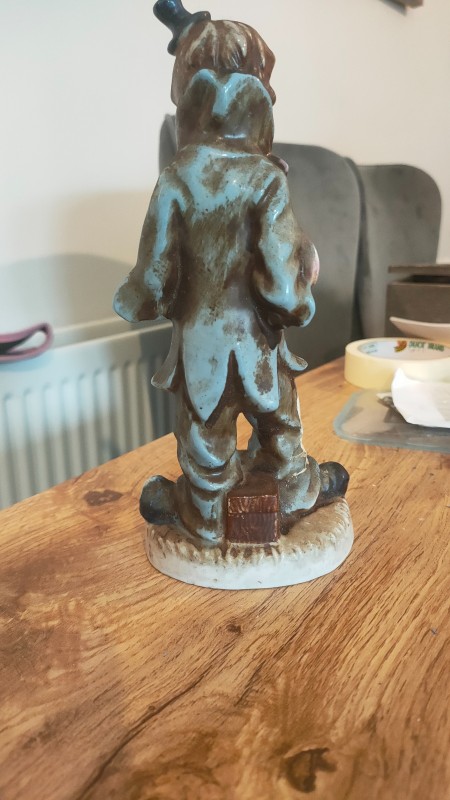
Your figurine looks a bit like the vintage 1980s Pucci Hobo Clown Figurine by Arnart (1984) www.ebay.com/
These unidentified figures are sold inexpensively, about $4 www.ebay.com/
picclick.com/
These pieces have been in the family for generations. I was told they were brought over from Germany. I am struggling to find any information on them or the mark on the back of each.
Any help would be greatly appreciated as We are looking to sell them. Thank you.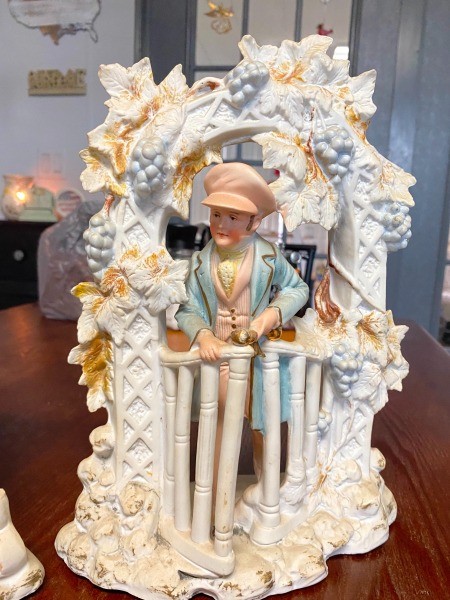
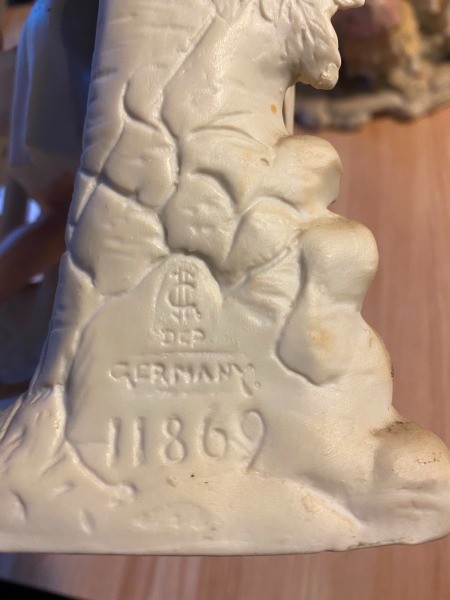
The DEP stamp on your figurines does not help in any way to identify the figurines. This mark is commonly found on German or French bisque dolls, celluloid, porcelain, jewelry, glass or metal goods. Dep stands for the German word Deponiert which means registered, or copyright. Dep is also a shortened form of Depose which is French for registered.
The stamp on your figurines is often confused with GH - Gebruder Heubach (translated as the Heubach Brothers) from Lichten, Germany, which is best known for bisque dolls and doll heads as well as a small number of collectible and expensive figurines.
You have bisque figurines made by Porzellanfabrik Schneider, Germany.
Based on a ducal concession, the businessman Carl Schneider (who had worked at the Wallendorf factory for some time) together with modeling artist Karl Unger and businessman Hermann Hutschenreuther founded their business in 1859. As Hutschenreuther was a sleeping partner, his name does not appear in the company name until 1885.
The name of the factory has changed slightly over time:
1859 until 1885 - Porzellanfabrik Unger, Schneider & Cie.
1885 until 1886 - Porzellanfabrik Schneider & Hutschenreuther
1886 until 1951 - Porzellanfabrik Carl Schneiders Erben
1951 until 1972 - V.E.B. Porzellanfiguren Gräfenthal
The V.E.B. Porzellanfiguren Gräfenthal was dissolved in 1972 and the defunct factory of Carl Schneiders Erben was finally closed 1973 after finishing the last figurines still made in 1972. www.porcelainmarksandmore.com/
The stamp on your figurines was used between 1879 and 1886 (the common version with the 'Dep.' Addition) www.porcelainmarksandmore.com/
Prices vary (excluding shipping costs) from $16 www.ebay.com/
www.ebay.com/
www.etsy.com/
You have very beautiful figurines. You didn't write the size of your figurines. I think the price of each is about $95-150 www.ebay.com/